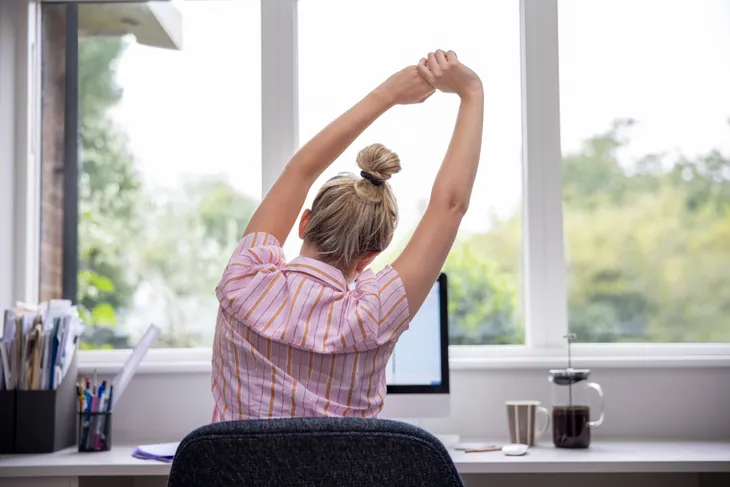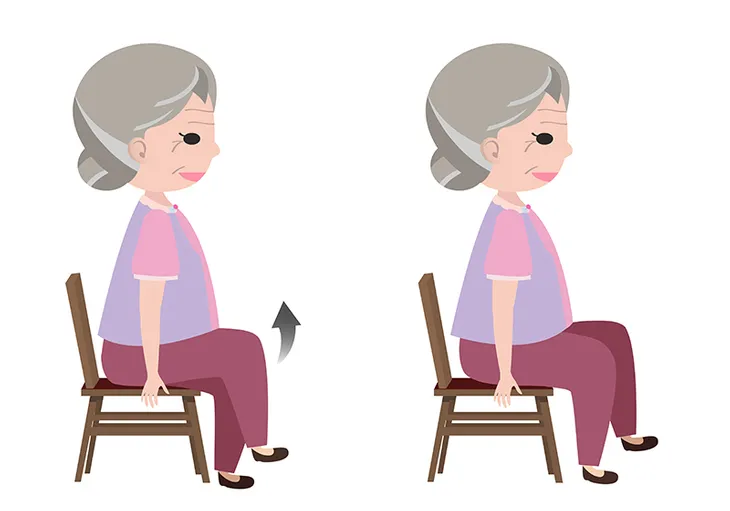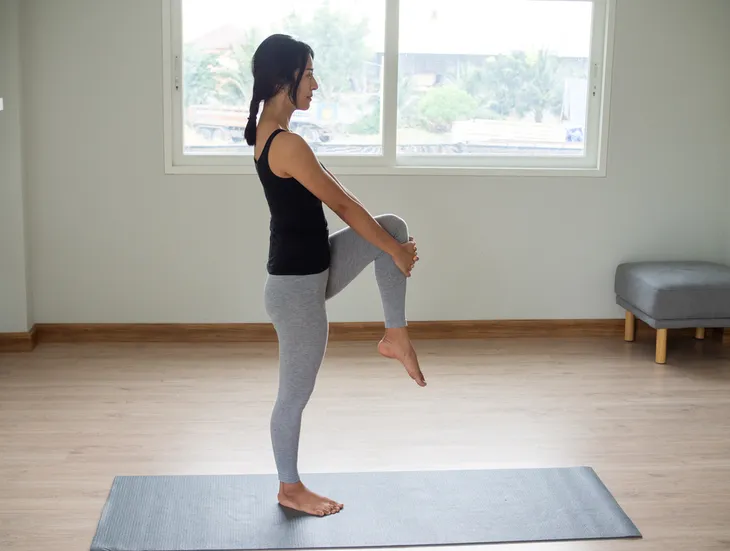- Blood clots are often the result of inactivity (sitting at a desk or during travel) or a sedentary lifestyle, and if left untreated they can become fatal.
- The best way to combat blood clots is to incorporate movement throughout your daily routine.
- Exercise doesn’t have to be complex – movement is the key. Many of these exercises can be performed from a seated position and will help promote blood flow.
Our bodies are constantly pumping blood, it’s how we stay alive. And while it’s true, clots can be helpful to stop the flow of blood from a cut or injury, they can also form in our bodies and wreak havoc. A common condition associated with clots is deep vein thrombosis (DVT) which typically occurs in the lower leg or thigh. If left untreated, Everyday Health warns that these blood clots can break free and cause a blockage elsewhere in the body, like the lungs (pulmonary embolism), and become fatal.
According to the American Blood Clot Association, DVT is usually due to a lack of exercise or inactivity. “Pooling occurs when gravity plus inactivity makes it difficult for the blood vessels to pump blood back up to the heart and lungs,” notes the source. Movement is the best way to combat pooling and keep circulation in motion. Here are 12 easy exercises that promote good blood flow and can reduce the risk of blood clots.
Overhead Stretch
There’s no better feeling than a nice big stretch! Stretching is very important, especially when confined to one place. It helps release tension and prevent blood clots. For a good overhead stretch, raise both hands in the air over your head. Use one hand to grab the other and gently pull to one side. Be sure to lean into the opposite side. For example, if your left hand is grabbing your right wrist, lean into the left side.
Hold this stretch for 15-seconds and then switch sides. You can do this move as many times as needed. You might want to try it a couple times! You’ll notice the more times you do it, the farther you’re able to lean.
Forward Flex
The forward flex is essentially just folding one half of the body over the other for a beautiful stretch along the back of the legs. You can do this exercise while lying down or from a standing position. Start with both feet planted firmly on the floor, then slowly bend forward and reach for your ankles.
It’s okay if you can’t quite reach your ankles, you’ll still reap the benefits. Hold this stretch for 15-seconds, then return to a normal position.
Shoulder Stretch
While blood clots in the upper body aren’t as likely, it’s still a good idea to promote circulation. A great place to target is the shoulders. The shoulder stretch can be done either from a standing or sitting position.
Start by taking your right hand and bringing it behind the left shoulder. Use the left hand to gently pull on the right elbow, bringing it toward your body. Hold this stretch for 15-seconds and repeat it on the opposite side.
Walking
No surprise here, walking is one of the easiest and best forms of exercise. Even the busiest people can find some time in their day to go for a walk. Try a couple 15-minute walks throughout the day, or even better, once every hour or two. It doesn’t even have to be outside! You can take a walk around the office. The main thing is to get moving.
“Not only will this help get the blood pumping and help prevent blood clots, it will also help your overall mood and give your brain a break, so you’ll be so much better at getting back to whatever you’re doing,” says Rachel Rosovsky, MD, a hematologist at Massachusetts General Hospital in Boston when talking to Everyday Health. If you’re stuck on a long flight, get up from your seat and take a walk up and down the aisle. If you’re on bed rest in recovery, even just moving from your bed to a chair will help with blood circulation.
Ankle Rotations
Snap, crackle, POP! That’s what most people hear when they rotate their ankles and if that’s the case, it’s probably a good thing you’re doing it! Not only do ankle rotations (or ankle circles) help release built-up tension in the joints, but they also prevent blood clots.
To get the most range of motion, you’ll need to lift your feet off the floor (from a seated position, of course). As the feet are lifted, turn them in a circular motion as if drawing circles with your toes. Continue for a minimum of 15-seconds, then switch directions. You can perform this exercise as many times as needed.
Seated March
We’ve already mentioned walking as a great form of movement to prevent blood clots. While we firmly believe everyone has time to take a brief walk around throughout the day, another option would be to march in a seated (or standing) position. This is great for people who are confined to sitting for long periods of time like during travel.
This exercise is fairly self explanatory and is essentially just walking on the spot without moving. However, WebMD provides instructions on a more exaggerated march which involves lifting the knee up toward your chest, then returning your foot back down to the floor. Do this move on each leg and repeat 30 times every hour.
Thigh Stretches
You can do this exercise from a seated position or while standing if you’re feeling confident about your balance. For those who are sitting, lift your leg into the air while maintaining a bend at the knee.
For those who’ve chosen to do this one while standing, pick up your leg and bend it at the knee. Take your bent leg and lift it up to your chest. Return it back to the starting position and repeat with the other leg.
Foot Pumps
Foot pumps are another exercise that can be done from a seated position. To perform a foot pump, keep your heels firmly on the floor and “lift the front of your feet toward you as high as possible,” explains National Blood Clot Alliance. Hold this position for a second or two before lowering them back down. To ensure you’re holding the exercise for long enough, count to three in your head.
Once the feet are flat again, lift your heels up as high as they can go while keeping the balls of your feet on the ground. Continue this exercise for 30-seconds and repeat as needed.
Neck and Shoulder Rolls
Two easy moves that can be done from a seated position are a neck and shoulder roll. When it comes to the neck, start by relaxing the neck and shoulders. “Then drop your right ear to your right shoulders and gently roll your head forward and to the other side, holding each position about 5 seconds,” writes the source. Repeat this move at least 5 times.
A shoulder roll is done by lifting the shoulders up as if you’re shrugging them, then pull them backward, downwards, and forward. They should move in a circular motion, says National Blood Clot Alliance. Once completed, switch directions.
Leg Raises
To perform a leg raise, slowly raise your left foot off the floor so that it’s parallel with your knee, says Everyday Health. Hold this position for a couple of seconds and then lower it back down to the floor. Try not to simply drop the leg back down, but rather lower it at the same speed it was raised. This is a great exercise for someone who is confined to a bed as it can be done from either a seated position or while laying down.
Remember to keep breathing throughout this exercise and repeat this same move with the right leg. Aim for 10- to 20-repetitions on each leg, three to four times a day.
Open Hips
Our hips are one area we often forget to stretch but when we do it feels incredible! We use our hips a lot. We use them when walking, standing, and even more so when sitting for long periods of time. This stretch is especially important for people who spend a lot of time sitting.
While in the seated position, open your legs up to the sides (if there’s room). Gently lean forward while applying pressure into the chair and you’ll feel an amazing stretch through the groin and into the hips. Hold this move for 10- to 30-seconds and repeat as many times as necessary.
Arm Curls
Arms curls are exactly what they sound like, essentially a bicep curl but without any weights. The best way to perform this exercise is from a seated position in a chair with arms. To start, place your arms on the chair rests and bend them at a 90-degree angle. “Raise one hand up to your chest and back down,” writes National Blood Clot Alliance.
You should alternate between each arm so they both get the same number of curls. Continue this exercise for at least 30-seconds and repeat as needed.















